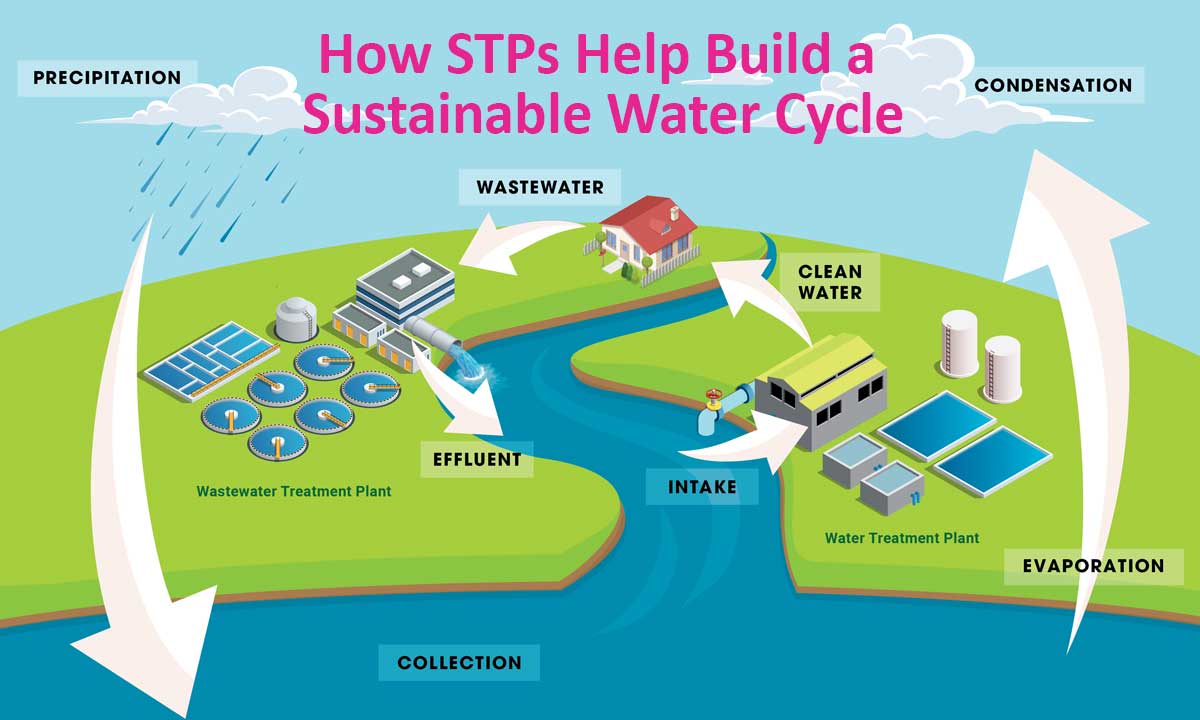How Sewage Treatment Plants Support a Sustainable Water Cycle
Water is the foundation of life, crucial for drinking, agriculture, sanitation, and industry. Yet, increasing population, urbanization, and climate change are putting immense pressure on freshwater resources. To protect these vital resources and meet rising demand, we must treat and reuse water effectively.
Sewage Treatment Plants (STPs) are essential in this process. By treating wastewater and making it suitable for reuse or safe discharge, STPs play a vital role in closing the loop of the sustainable water cycle. As one of India’s leading sewage treatment plant manufacturers, 3D AQUA has been at the forefront of providing efficient, cost-effective, and eco-friendly STP solutions for industries, municipalities, and agriculture.
The Importance of a Sustainable Water Cycle
A sustainable water cycle ensures that water is continuously used, treated, and reused with minimal loss and environmental damage. In this model:
- Freshwater demand is reduced.
- Pollution is minimized.
- Aquatic ecosystems are preserved.
STPs contribute directly to this sustainable approach by intercepting wastewater before it contaminates water bodies and restoring it for safe reuse.
Efficient Water Recovery in STPs
One of the most direct ways that STPs contribute to a sustainable water cycle is through efficient water recovery. Treated water from STPs can be reused for:
- Agricultural irrigation
- Industrial cooling
- Landscaping
- Toilet flushing
Here are the main stages of water recovery in STPs:
1. Primary Treatment
In this initial phase, physical processes are used to remove large solid materials such as plastics, rags, and grit. The wastewater passes through screens and settling tanks, leaving behind a partially clarified liquid.
2. Secondary Treatment
This biological process uses aerobic bacteria to break down organic matter and dissolve pollutants. Activated sludge systems and biofilm reactors are commonly used to treat the wastewater further.
3. Tertiary Treatment
In this advanced treatment stage, fine filtration and disinfection remove any remaining contaminants. Techniques such as ultrafiltration, UV disinfection, and ozonation ensure that the treated water meets regulatory standards for reuse.
3D AQUA incorporates all three stages in its modular STP designs, ensuring maximum recovery with minimal energy and chemical usage.
Pollution Control and Environmental Protection
Wastewater from homes, industries, and institutions carries pollutants like organic waste, pathogens, chemicals, and nutrients. If released untreated, this water can degrade natural ecosystems and pose health risks. STPs play a crucial role in pollution control, improving environmental health and water quality.
Solid Removal
Primary clarifiers and sedimentation tanks effectively remove suspended solids, reducing organic load and sludge buildup in downstream processes.
Nutrient Removal
Excessive nitrogen and phosphorus in wastewater can lead to eutrophication in rivers and lakes. Modern STPs use processes like biological nutrient removal (BNR) to reduce nutrient levels, making the effluent safer for discharge.
Disinfection
Final disinfection steps using UV or ozone eliminate pathogens without leaving harmful chemical residues. This protects both aquatic life and human health.
3D AQUA ensures that its STPs are engineered with pollution control in mind. Their systems meet CPCB and SPCB standards while also offering low operational costs.
Resource Conservation through STPs
Another way STPs support sustainability is through resource conservation. Innovations in wastewater treatment enable the recovery of energy, nutrients, and other valuable by-products.
Energy Efficiency
3D AQUA designs energy-optimized STPs that consume less power by incorporating:
- Solar panels for auxiliary energy supply
- Energy-efficient motors and blowers
- SCADA-based automation for intelligent control
Sludge Management and By-product Utilization
The sludge generated in the treatment process is not waste. When treated and stabilized, it can be converted into:
- Biogas via anaerobic digestion
- Organic compost for agriculture
- Soil conditioners for landscaping
These applications reduce landfill dependency and promote a circular economy in water management.
Environmental Safeguards and Ecosystem Benefits
A functioning STP safeguards the environment by ensuring that discharged water does not degrade land or water ecosystems.
Improved Habitat Quality
Clean effluents support fish spawning and aquatic biodiversity. Safe water discharge helps maintain the ecological balance of nearby water bodies.
Soil Fertility Support
Treated sludge and compost improve soil structure and fertility, which is especially beneficial in water-stressed agricultural regions.
By focusing on holistic sustainability, 3D AQUA’s STPs contribute positively to local ecosystems and biodiversity.
Adapting STPs for Urban and Rural Needs
India faces water scarcity in both urban cities and rural areas. 3D AQUA customizes STPs to meet the unique challenges of each setting.
Urban Solutions
In dense cities, 3D AQUA deploys compact and decentralized STPs for:
- Residential complexes
- Commercial buildings
- Municipal sewage systems
These systems save space and operate quietly, making them suitable for urban environments.
Rural Applications
For remote areas, the company offers low-maintenance STPs that:
- Operate without grid electricity
- Require minimal skilled labor
- Support community-scale water reuse
Meeting Regulatory and Sustainability Standards
With increasing environmental regulation, compliance has become critical. 3D AQUA helps its clients achieve and maintain:
- CPCB & SPCB approvals
- Zero liquid discharge (ZLD) targets
- ESG and CSR sustainability goals
The company also offers AMC, O&M, and retrofitting services to keep older systems in compliance.
Conclusion
Sewage Treatment Plants are the unsung heroes of the sustainable water cycle. They recover water, prevent pollution, conserve resources, and protect the environment. With innovations in design, automation, and reuse technologies, modern STPs are not just waste treatment systems – they are engines of sustainability.
3D AQUA has helped numerous clients – from smart cities to agrarian communities – to adopt sewage treatment solutions that work for people and the planet.
For more details or to request a site evaluation and consultation, contact the experts at 3D AQUA today.
📞 Contact 3D AQUA:
Phone: +91-6262629090
Email: info@3daqua.in
Website: www.3daqua.in

